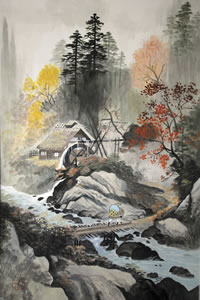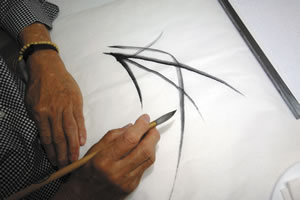The Zen of Art
Thanks to one dedicated teacher, Sachie Saigusa, an ancient Japanese art form thrives in Honolulu

By .(JavaScript must be enabled to view this email address)
E-mail this story | Print this page | Archive | RSS

|
Sumi e simply means black ink painting. But the precise brush techniques needed to produce the ancient art are anything but simple. Rooted in centuries of Zen Buddhist teachings, Sumi e is said to reflect the clarity, simplicity and concentration of the monks who first mastered the art, while at the same time symbolizing the values of bushido - the Samurai code of conduct exhibited in feudal Japan.
The kupuna who will display their works of art at Honolulu Hale through May 6 won’t likely qualify for either position, but like their religious and warrior forebears, they have found great fulfillment in an art form that requires both speed and patience, careful attention to detail and individual expression.
Now in its ninth year, the annual show also is displaying examples of Nihonga, Japanese-style paintings featuring traditional themes and made with special inks, and Senmen, or fan painting.
The teacher is 84-year-old Sachie Saigusa, who moved to Hawaii at the age of 29 with her husband, Takamaro, a longtime Buddhist priest on Oahu and the Big Island.
Saigusa was a young teacher in 1945 in Hiroshima when the hydrogen bomb exploded. The blast ripped the roof off the school as everyone hid in the basement for protection. Though she wasn’t hurt by the shock-wave that leveled the entire city, the radiation burned her skin and eventually led to cancer. Over the years she would suffer through seven surgeries to repair the recurring damage. The last was a lung operation just two years ago. Not that you’d ever know. The humble and always-smiling teacher is more focused on her students and the joy they get from the art.

|
“Some of the people are 95 years old, and I think it is really healthy for the students because it’s relaxing, it is something they like to do and they get a lot of pleasure from completing it,” says Saigusa through a translator.
Saigusa is employed by the state Department of Education’s Community School for Adults, and her students meet each Monday at the Makua Alii Senior Center, Wednesdays at Moiliili Community Center and Thursdays at Wahiawa Community Center. The smiling octogenarian also volunteers twice a month at Honpa Hongwanji Mission of Hawaii.
One of the challenges for Sumi e artists is to create a memorable piece of art using only a single color and basic, traditional themes. But in the hands of someone like Saigusa, those limitations can have a powerful effect as the contrast of simple colors creates stirring images.
Such elements can be found in any number of Japanese practices where appreciation comes from the careful control of simple elements. This can be seen in Ikebana, Japanese flower arrangement, or even in a steaming bowl of ramen, which on the surface looks simple, but in fact can take years to master the exact combination of subtle flavors.

|
The exhibit features approximately 100 works of art from about 50 seniors, including those made by 81-year-old Fujiko Motobu, who has been studying with Saigusa for 10 years.
“I did one for practice and I dropped it and my dog ate it,” says the Aina Haina resident with a laugh. “I don’t know why, but it’s the second one he had eaten. So I had to draw another one.”
Motobu says it takes her about 25 hours to do a painting, which is often spread over one or two weeks. She says that even after participating in the art shows since the beginning, she still finds it exciting to see her art hanging in the Hale courtyard.
“Naturally, because of my ego,” laughs Motobu. “You tell all your children and grandchildren to go see Grandma’s paintings!
We do a different type of art each year, so it’s always exciting.”
One artist whose work isn’t on display is the teacher - whether because of shyness or to focus on her students, she isn’t saying which, works by the teacher with nearly 30 years experience remain unseen except by her students.
“I wish she would show her paintings, but she just won’t do that,” says Motobu. “Sensei creates a sample of each week’s lesson to show her students, which means she is creating some 50-60 paintings a week. Perhaps with all that work, her own personal efforts are not being featured in the gallery. This is all about the students.”
The exhibit is open week-days from 9 a.m. to 4 p.m.
Page 1 of 1 pages for this story
E-mail this story | Print this page | Comments (0) | Archive | RSS
Most Recent Comment(s):








